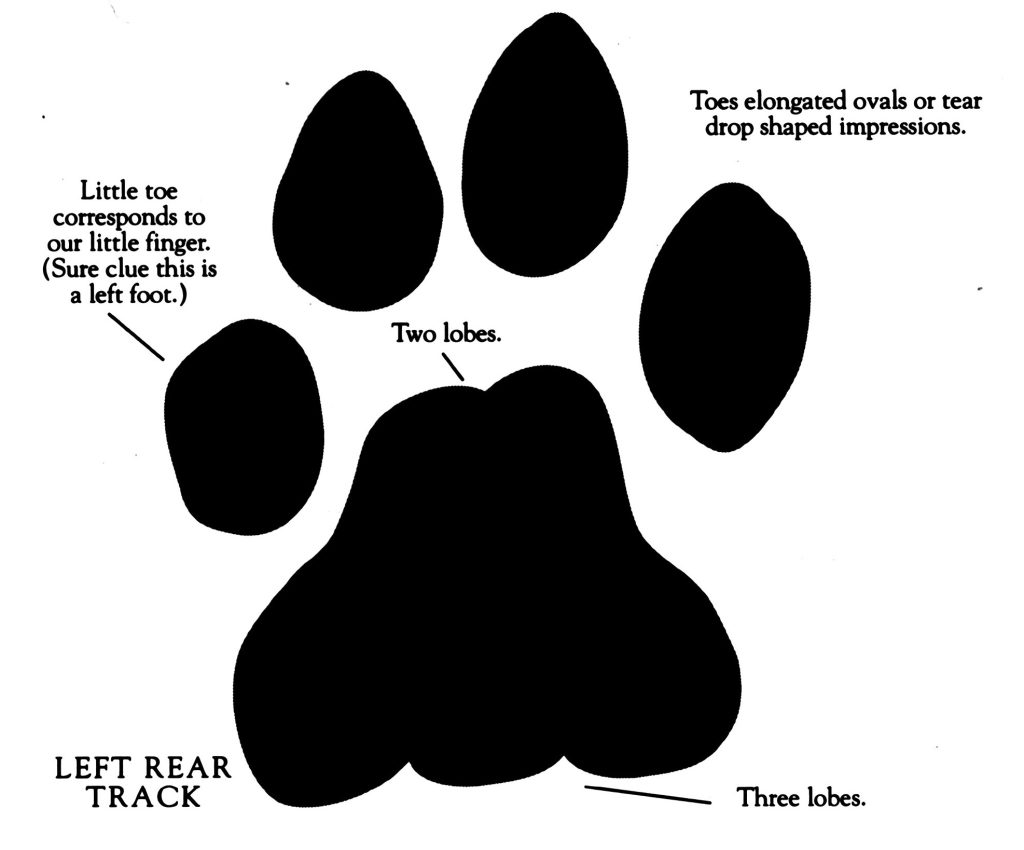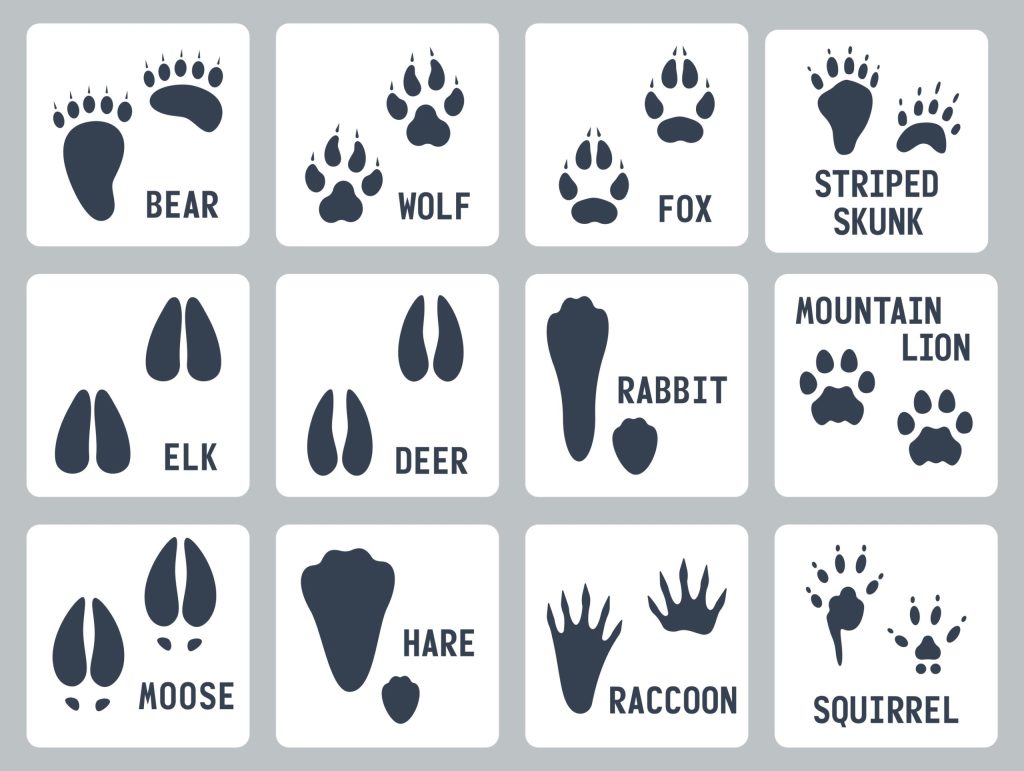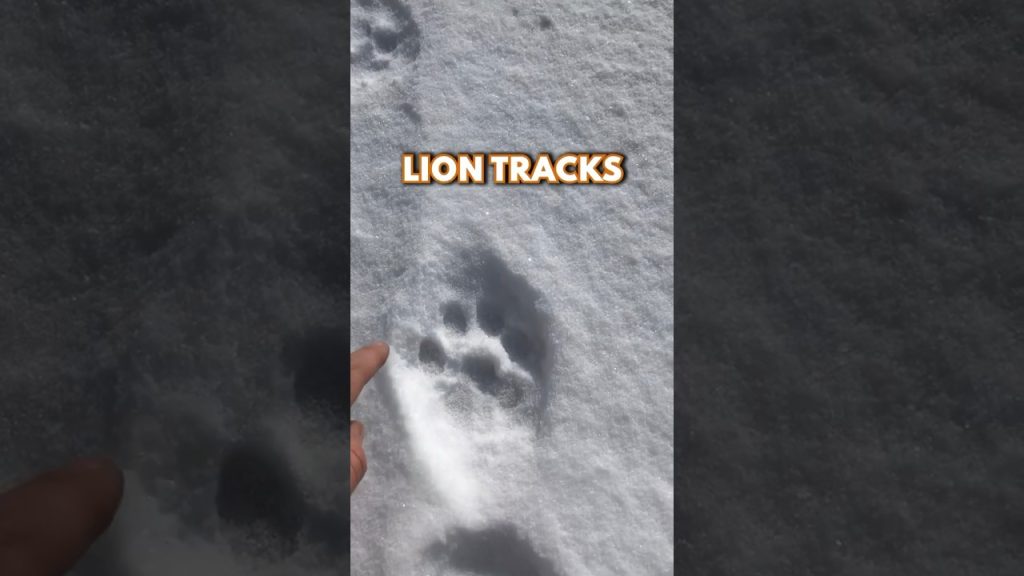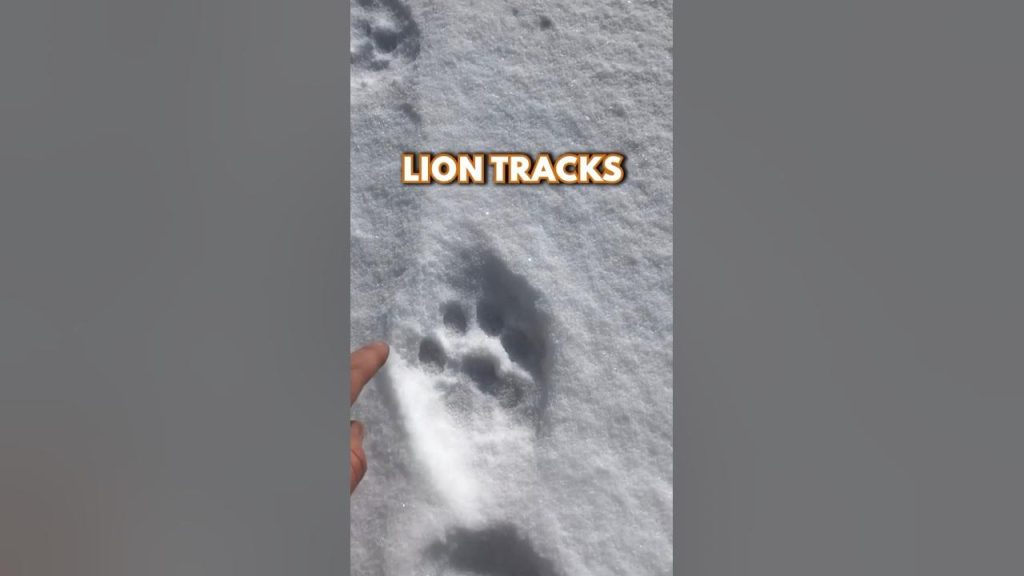So, you’ve found yourself out in the wild, curious about the fascinating world of lions. You might be wondering, how can you tell if lions have recently roamed the area? Well, fret no more, because we’ve got you covered. In this article, we’ll take you through the ins and outs of identifying lion tracks and signs in the wild, straight from the experts themselves. From distinguishing lion footprints from other animals to spotting marking trees and territorial signs, get ready to unravel the secrets of these majestic creatures. Whether you’re a wildlife enthusiast or just a curious explorer, this guide will equip you with the knowledge you need to decode the wild and discover the presence of lions around you.

Identifying Lion Tracks
When tracking lions in the wild, it is essential to know how to identify their tracks accurately. Lion tracks can provide valuable information about the size, shape, and behavior of these majestic animals. By carefully examining the tracks, you can gain insights into the lion’s territory, habits, and even its emotions. Here are some key factors to consider when identifying lion tracks.
Size and Shape of Tracks
Lion tracks are generally large and have distinct characteristics that set them apart from other animals. Adult lion tracks can measure around 4 to 5 inches in width. The overall shape of the track is roundish, with a slightly asymmetrical appearance. The front paw tracks are generally larger and show more defined claws compared to the hind paw tracks.
Number of Toes
Lion tracks typically have four toes, with the claw marks often visible in the tracks. The presence of four toes can help distinguish them from tracks of other big cats, which usually have five toes. However, it’s worth noting that the fifth toe might occasionally leave an impression in the track, but it is usually not as prominent as the other four.
Claw Marks
Lions have retractable claws that they use for hunting and climbing. When examining lion tracks, it is important to look for claw marks. These marks are usually visible in the tracks, especially in the front paw tracks. The claws might not always be fully extended, but you can often see slight indents or marks where the claws have dug into the ground.
Pad Markings
Lion tracks have distinct pad markings that can help identify them. The pads are generally large and slightly asymmetrical in shape. Look for the presence of three lobes at the bottom of the pad, as this is a typical characteristic of lion tracks. The front paw pads are usually more rounded, while the hind paw pads have a slightly more elongated shape.
Gait or Foot Pattern
Another way to identify lion tracks is by analyzing the gait or foot pattern left behind. Lions usually walk with a diagonal pattern, where the hind paw is placed in the same spot where the front paw was, but staggered. This gait creates a flowing, almost continuous track as the lion moves forward. By observing the foot pattern, you can gain insights into the lion’s speed and behavior.
Lion Territories and Habitats
Understanding lion territories and habitats is crucial for tracking them effectively. Lions have specific home ranges and engage in territorial marking behaviors to establish their dominance and defend their territory from other lions. By examining the signs left behind in their territory, you can gather valuable information about their habits and movements.
Home Ranges
Lions have large home ranges, which can vary depending on the availability of prey and suitable habitat. In some cases, a male lion’s home range can extend up to 100 square miles, while a female’s range is typically smaller, around 10-25 square miles. By studying the size and location of the tracks, you can estimate the lion’s home range and potentially track its movements over time.
Territory Marking
Lions mark their territories in various ways, and understanding these signs can reveal a lot about their presence and behavior. One common method of territory marking is through scratch marks on trees. Lions use their claws to leave deep scratches on tree trunks, often applying their scent to the marks as well. By observing these scratch marks, you can determine if a particular area is within a lion’s territory.
Scat or Fecal Matter
Examining lion scat or fecal matter can provide valuable insights into their diet and recent activities. Lion scat is usually large in size, cylindrical in shape, and has a strong odor. By analyzing the contents of the scat, such as bones, hair, or undigested food, you can gain an understanding of the lion’s recent meals and its hunting habits.
Kills and Feeding Sites
Tracking lions can also involve identifying their kill sites and feeding areas. Lions often drag their prey to a secluded location, such as dense vegetation or rocky outcrops, to consume it. Look for signs of disturbed vegetation, bloodstains, and scattered bones in an area to identify potential kill sites. These signs can give you a sense of the lion’s feeding habits and the types of prey it targets.
Behavioral Signs of Lions
In addition to physical tracks and territorial markings, there are several behavioral signs that can help you identify the presence of lions in the wild. These signs can give you a deeper understanding of their social interactions, vocalizations, and overall behavior.
Roaring and Vocalizations
Lions are well-known for their powerful roars and vocalizations, which they use to communicate with other members of their pride. Being able to identify and differentiate lion roars from other animal sounds can greatly assist in tracking their whereabouts. The deep, resonating roar of a male lion can carry over long distances, often serving as a territorial call to other lions in the vicinity.
Scent Marking and Spraying
Lions use scent marking as a form of communication and territory demarcation. They have specialized scent glands located on their cheeks, forehead, and hindquarters. Lions rub these scent glands on trees, rocks, or the ground, leaving behind distinctive odors. In addition to rubbing, lions also engage in spraying, where they forcefully release urine to mark their territory. Identifying these scent markings can indicate the presence of lions and their dominance within a particular area.
Clawing and Scratching
Lions actively engage in clawing and scratching behaviors as part of their territorial marking. By using their powerful claws, they leave deep claw marks on tree trunks and other surfaces. Scratching behaviors are often accompanied by scent marking, as lions will rub their scent glands against the claw marks. The presence of both scratch marks and scent glands can indicate the presence of lions and their territories.
Young Lion Activities
When tracking lions, it’s crucial to be aware of the signs left behind by young lions. Young lions are often more playful and curious, leaving behind evidence of their activities. Look for tracks that appear smaller in size and show signs of playfulness, such as scattered indents or side-to-side movements. Young lions may also leave behind chewed sticks or partially destroyed vegetation, as they explore and learn about their environment.
Social Interactions
Lions are social animals that live in prides consisting of several individuals, typically led by a dominant male and female. Observing social interactions can provide valuable insights into their behavior and relationships. Keep an eye out for tracks that show multiple lions moving together, or signs of grooming and nuzzling between individuals. These interactions can help you understand the dynamics within a pride and its structure.
Distinguishing Lion Signs from Other Animals
While tracking lions, it is important to be able to differentiate their signs from those of other animals. By understanding the key differences between lion tracks and signs left by other species, you can avoid misinterpretations and accurately identify the presence of lions in the wild.
Comparison with Other Big Cats
One common challenge is distinguishing lion tracks from those of other big cats, such as leopards or cheetahs. While they may have similarities in size and shape, there are some key differences to look out for. Leopards, for example, have retractable claws like lions but usually leave a smaller and more rounded track. Cheetahs, on the other hand, have non-retractable claws and a distinctive teardrop-shaped track.
Differentiating from Dogs and Hyenas
Dog tracks and hyena tracks can sometimes be confused with lion tracks due to their similar size and shape. However, there are notable differences to consider. Lions generally have larger tracks than both dogs and hyenas, and their tracks often exhibit more defined claw marks. Dogs, such as domestic dogs or wild canids, usually have rounder tracks with more prominent nail markings. Hyenas, on the other hand, have asymmetrical tracks with only four toes, like lions, but their tracks are generally larger and show less distinct claw marks.
Differentiating from Wild Herbivores
In areas where there is abundant wildlife, it can be challenging to differentiate lion tracks from those of wild herbivores, such as antelopes or elephants. One key distinction is the shape and structure of the tracks. Herbivores have hooves, leaving behind split or rounded tracks. Lions, with their padded paws and distinct claw marks, will leave an entirely different impression on the ground. Additionally, the presence of territorial markings and scent can further confirm the presence of lions.
Differentiating from Humans
In some instances, it is crucial to differentiate lion signs from human tracks or activities. Humans can inadvertently leave behind tracks or signs that may resemble those of lions. However, there are key differences to look for. Human footprints generally have a more uniform shape and lack the presence of claw marks. Additionally, human activities such as littering or clearing vegetation can help distinguish human presence from that of lions.

Tracking and Monitoring Techniques
Tracking and monitoring techniques are essential for effectively studying lion behavior and movements. By employing various tracking methods, researchers and wildlife enthusiasts can gather valuable data on lion populations, migration patterns, and their interactions with the environment.
Basic Tracking Skills
Developing basic tracking skills is essential for anyone interested in tracking lions or any other wildlife species. Learning how to study tracks, interpret signs, and understand animal behavior can significantly enhance tracking abilities. It is crucial to learn from experienced trackers or wildlife experts who can provide guidance and share knowledge.
Use of Tracking Devices
Modern technology has greatly aided tracking efforts with the use of tracking devices. GPS collars attached to lions allow researchers to monitor their movements remotely. By tracking the signals from the collars, researchers can gain insights into lion territories, migration patterns, and potential conflicts with human settlements. Tracking devices have revolutionized the field of wildlife research and conservation.
Camera Traps and Remote Sensing
Camera traps have become instrumental in tracking and monitoring lions, especially in remote or inaccessible areas. These motion-activated cameras capture images or videos of lions and other wildlife, providing researchers with valuable data on their behavior and population dynamics. Remote sensing techniques, such as satellite imagery, can also provide insights into lion habitats and land use patterns.
Nighttime Tracking
Tracking lions at night can be a thrilling and challenging experience. Lions are primarily nocturnal animals, and their behavior often changes during the nighttime hours. Using specialized equipment, such as night vision goggles or thermal imaging cameras, can aid in tracking lions during low-light conditions. However, it is crucial to prioritize safety and seek guidance from experts when tracking lions at night.
Expert Guidance
When tracking lions, it is always beneficial to seek guidance from experts or professional guides. They have extensive knowledge and experience in tracking wildlife, ensuring that tracking efforts are conducted safely and responsibly. Experts can provide valuable insights, identify signs that may be easily overlooked, and share their expertise on lion behavior and habitat preferences.
Lion Conservation and Research
Lion conservation and research efforts are crucial for ensuring the survival of these iconic animals. By conducting population studies, understanding migratory patterns, mitigating human-wildlife conflicts, and implementing conservation measures, we can help protect lions and their habitats for future generations.
Lion Population Studies
Evaluating lion populations is essential for assessing their conservation status and identifying conservation priorities. Population studies involve conducting comprehensive surveys and monitoring programs to estimate the number of lions in specific areas. These studies also provide insights into population trends, habitat suitability, and potential threats to lion populations.
Migratory Patterns
Understanding lion migratory patterns is crucial for maintaining connectivity between different lion populations. Lions often move across vast landscapes in search of suitable habitats, mates, and prey. By studying their migratory patterns, we can identify critical corridors and implement measures to prevent habitat fragmentation, which can negatively impact lion populations.
Human-Wildlife Conflict
Human-wildlife conflict is a significant challenge for lion conservation. As human populations expand and encroach upon lion habitats, conflicts arise, resulting in livestock predation and threats to human safety. Developing strategies to mitigate these conflicts, such as implementing predator-proof enclosures for livestock or employing early-warning systems, is essential for peaceful coexistence between humans and lions.
Livestock Predation
Lion predation on livestock can lead to retaliation from local communities and pose a threat to lion populations. Implementing measures to reduce livestock predation, such as improving corral designs or providing compensation for losses, can help alleviate conflicts and ensure the protection of both lions and livelihoods.
Conservation Efforts
Various conservation organizations and initiatives are dedicated to protecting lions and their habitats. These efforts include establishing protected areas, implementing community-based conservation programs, and raising awareness about the importance of lions for ecosystem health. Supporting these conservation initiatives through donations or volunteer work can make a significant impact in securing the future of lions in the wild.

Safety Precautions while Tracking Lions
Tracking lions in the wild can be an exhilarating experience, but it is essential to prioritize safety for both humans and lions. Here are some safety precautions to keep in mind when tracking lions:
Professional Guide or Tracker
When tracking lions, it is advisable to have a professional guide or tracker with you. Their expertise and experience can ensure that tracking activities are conducted safely and responsibly. They can provide valuable insights into lion behavior, offer guidance in potentially dangerous situations, and help minimize any potential risks.
Maintaining Distance
Keeping a safe distance from lions is crucial for both our safety and their well-being. Lions are wild animals, and approaching them too closely can be dangerous. Respect their space and observe from a distance, using binoculars or camera lenses to get a closer look. Avoid disrupting their natural behavior or causing unnecessary stress.
Avoiding Surprises
When tracking lions, it is essential to make your presence known to avoid any surprise encounters. Make noise, talk loudly, or clap your hands to alert the lions of your presence. This helps prevent accidental surprises, promoting a more peaceful coexistence between humans and lions.
Awareness of Surroundings
Being aware of your surroundings is vital while tracking lions. Pay attention to any signs or warnings of potential dangers, such as fresh tracks or territorial markers. Be cautious of other wildlife in the area, as their behavior can indicate the presence of lions nearby. Always stay vigilant and avoid risky or unfamiliar situations.
Responsible Behavior
Responsible behavior is key when tracking lions. Avoid littering, respect the natural environment, and follow any guidelines or regulations in the area. Keeping a low impact on the ecosystem helps preserve the natural habitat of lions and protects the delicate balance of the ecosystem.
Tracking Etiquette and Legal Considerations
When engaging in lion tracking activities, it is essential to follow specific etiquette and legal considerations to ensure a positive experience for both humans and wildlife.
Permits and Regulations
Before embarking on lion tracking activities, ensure that you have the necessary permits and abide by any regulations or guidelines in the area. Different regions or wildlife reserves may have specific rules regarding tracking or approaching wild animals. Respect these regulations to promote responsible wildlife viewing and conservation practices.
Respecting Wildlife and Environment
Respecting wildlife and the environment should be a top priority when tracking lions. Avoid interfering with their natural behavior or disturbing their habitat. Do not feed or approach lions, as this can disrupt their natural instincts and potentially lead to aggressive behavior. Leave no trace behind and avoid damaging or removing any vegetation.
Ethical Photography
Photographing lions is a popular activity while tracking. However, it is crucial to do so ethically. Avoid using flash photography, as it can startle or distress the lions. Maintain a safe distance and use long lenses to capture detailed shots without getting too close. Remember that the welfare of the lions should always come before capturing the perfect photo.
Contributing to Conservation
Engaging in lion tracking activities is an excellent opportunity to contribute to conservation efforts. Support local conservation organizations, donate to lion conservation programs, or participate in community-based initiatives that aim to protect lions and their habitats. By contributing to conservation, you directly help ensure the future of these magnificent animals.
Sharing Knowledge and Experiences
Finally, sharing knowledge and experiences gained from lion tracking can help raise awareness about the importance of lion conservation. Educate others about the challenges facing lions and the need for their protection. Share your photographs, stories, and insights responsibly, encouraging others to appreciate and respect these majestic animals.

Common Mistakes in Identifying Lion Tracks
Identifying lion tracks can be challenging, especially for those new to tracking. However, being mindful of common mistakes can help improve accuracy and avoid misinterpretations. Here are some common mistakes to be aware of:
Confusing with Dog Tracks
Dog tracks can sometimes resemble lion tracks due to their similar size and shape. However, careful observation can help differentiate between the two. Lions have larger tracks with distinct claw marks, while dogs have more rounded tracks with prominent nail markings. Pay attention to the overall shape, size, and presence of claw marks to avoid mistaking dog tracks for lion tracks.
Misinterpreting Freshness of Tracks
Determining the freshness of lion tracks can be challenging, especially in areas with high wildlife activity. Factors such as wind, rain, or other animals crossing the tracks can alter their appearance over time. Relying solely on the visual appearance of tracks can lead to misinterpretations. Consider other factors, such as the overall condition of the track, presence of surrounding signs, or the scent associated with the tracks, to gauge the freshness accurately.
Overreliance on Single Sign
While tracks are an important aspect of tracking lions, overreliance on a single sign can lead to misinterpretations. Tracks should be considered in conjunction with other signs, such as territorial markings, vocalizations, or behaviors observed in the area. By looking at the bigger picture and considering multiple signs, you can make more accurate assessments.
Lack of Expert Guidance
Tracking lions requires expertise and experience. Lack of proper guidance from experts or experienced trackers can lead to incorrect identifications or unsafe situations. Seek guidance from professionals who can provide valuable insights into lion behavior, share tracking techniques, and help you navigate any potential challenges.
Ignoring Context
Examining lion tracks without considering the context can lead to misunderstandings. Factors such as the landscape, vegetation, or the presence of other signs can greatly influence the interpretation of tracks. Consider the broader context and gather information about the area to make a more informed assessment of lion tracks.
Conclusion
Tracking lions and identifying their tracks and signs in the wild is an art that requires patience, knowledge, and intuition. By understanding the size and shape of tracks, the number of toes and claw marks, and other indicators such as pad markings and gait, you can accurately identify lion tracks. Additionally, examining their territorial markings, analyzing scat and kill sites, and observing their behavior can provide valuable insights into lion territories and habits. Differentiating lion signs from those of other animals, mastering tracking techniques, and contributing to lion conservation efforts are essential aspects of becoming a skilled tracker. Always prioritize safety, respect the environment and wildlife, and share your knowledge and experiences responsibly. Tracking lions in the wild offers a thrilling and rewarding experience, and by doing so, you contribute to the preservation of these magnificent animals for generations to come.


